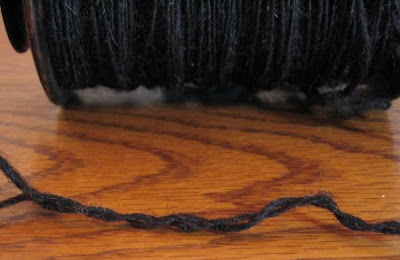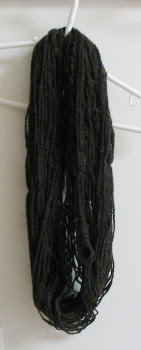That was my question when I first started spinning the Black Welsh roving from Judy. I toyed with the idea of spinning it as singles for weaving, but since I've been reluctant to jump into the waters of weaving with my own handspun, I thought perhaps it would be better to ply it. Needless to say, it has sat around on a bobbin for months. With another interesting spinning project imminent, I really needed that bobbin and so finally had to make a decision.
What I decided was to go ahead and ply it. I can still use it for weaving if I want, it will just make a chubbier weft. However, singles that aren't freshly plied and that sit around on bobbins for awhile, tend to temporarily set their twist. A single like this won't automatically try to balance itself when allowed to twist back on itself. Without that fresh energy, the question of how much plying twist to add becomes a challenge.
Here is what the single looked like when allowed to twist back on itself:

Looks too loose doesn't it? Of course, it often isn't possible to ply singles immediately after they are spun, so this is why I usually make a sample card. I not only attach a length of the single to the card, but also some freshly spun yarn plied back on itself. This tells me how my plying twist is required for a balanced 2-ply yarn. I also jot down any other information about the fiber: the breed, where it came from, fiber length, crimps per inch, wraps per inch, how I'm spinning it, etc. Unfortunately I lost or misplaced the sample card for the Black Welsh, and with it all that valuable information!
The thing to do was to re-energize the twist.
To do this I discarded several feet off the end of the bobbin. Then I broke off a short length and put it in a bowl of water.

The thing to do was to re-energize the twist.
To do this I discarded several feet off the end of the bobbin. Then I broke off a short length and put it in a bowl of water.

It didn't' take long before energy in the single "woke up" and started to twist back on itself. Now the twist was the same as when it was freshly spun. My challenge then, was try to ply so as to match my plying twist to the twist in this sample.


After I eyeballed a close enough match, it was simply a matter of counting treadles for the rest of the skein.
Here's what it looked like fresh off the niddy noddy:

Here's what it looked like fresh off the niddy noddy:


9 comments:
Oh man, have I been there. I'm spinning the last color for my lap robe. It's the last of our four Shetlands. I've had the other three colors processed but the black was too dirty to send away and so I'm picking through him and doing him a little at a time. I have a lot to learn about fiber washing and prep. It's kinda neppy and I think it's a result of something I did in the washing. I thought I was being really careful. I should just send it to Sherry at Morro Fleeceworks and let her work her magic. But for now, my deadline is to get this woven by the time of our fair.
I looked up summer and weave and seems that you have to change the tie-up for each block of pattern. I'm just not sure I have that kind of physical stamina and am thinking or using a fibonacci sequence in both warp and weft with a 2/2 twill weave. Whatya think?
Leigh, I am constantly amazed at the depth of your knowledge about spinning! The Black Welsh is lovely. That's what I learned the basics of spinning with. Of course mine was overspun because I have no idea what I'm doing! No re-energizing needed! Ha!
Pretty yarn and thoughtful post. I have a couple of skeins of silk that need some re-energizing.
It must be "bobbin clearing season". http://saralamb.blogspot.com/ is clearing them. I'm in the same mode: must clear some bobbins if I want to spin for a project.
Nice post. Nice Black Welsh Mtn. yarn.
Excellent post...I've got a few bobbins I need to free up too, I'll have to try this!
Nice save, Leigh! Been there a time or two myself. ;-) You did a wonderful job "waking" the energy back up.
I tend to always ply handspun I weave with - I feel it gives a better integrity to the finished piece and the piece will wear much better. Plus there is just something about a well done plied yarn that floats my boat. (lol)
I know what you mean when you are afraid when you put your plied yarn in the water! I hold my breath every time and am greatly relieved when all goes well.
I bow before the altar of your superior spinning knowledge!
Oh my, that looks lovely. I had never thought about soaking it in water and letting it ply on itself and working it out that way. neat.
Post a Comment